ARTICLE AD BOX

Drowning is one of the highest causes of accidental death among young children around the world. While no lesson can eliminate the risk entirely, swimming lessons dramatically lower the chances of tragedy.
Children should be well-taught with the basic and important survival skills like floating, treading water, reaching the surface, and swimming to safety. As focused on by the Harvard Health article, “Swimming Lessons Save Lives: What Parents Should Know,” early swim instruction can be a powerful tool in protecting children around water.
Why age 4 is the perfect time to start swimming lessons
At this age, most children have developed the cognitive and physical skills needed for structured learning.
They are better able to listen to instructions, follow them consistently, and remember what they’ve been taught. While some children may show signs of readiness a little earlier, age 4 is generally when they can truly begin to grasp swimming techniques and safety concepts in a more structured way.
Early swim exposure still has value
Even though children under 4 may not be developmentally ready for formal swim strokes, swim lessons at this age can still be beneficial.
Some toddlers can begin to learn basic water safety skills—like how to float, turn around in the water, or reach the pool’s edge. These small but critical abilities could make a big difference in an accidental water situation. Early exposure also helps build comfort and familiarity with the water, reducing fear later on.
The learning environment must be safe and well-supervised
Safety should never be assumed, it must be actively ensured. The pool or beach area where lessons take place should be clean, well-maintained, and have clearly marked boundaries between shallow and deep water.
It’s important that there are lifeguards on duty whose sole responsibility is monitoring safety not teaching. There should also be protective barriers to prevent unsupervised access to deeper areas, as well as visible safety rules, first-aid kits, and lifesaving equipment on hand.
Instructors should be properly trained and certified
Not every swim teacher is qualified, so it’s essential for parents to ask how instructors are trained and evaluated. Ideally, teachers should be certified through recognized organizations like the Red Cross, YMCA, or similar bodies that follow strict guidelines for water safety and child instruction because trained instructors are more equipped to teach effectively while responding to emergencies or unexpected situations.
Class sizes should be small and manageable
The number of children per instructor should be kept low, especially for young learners or beginners. A good rule of thumb is that the instructor should be able to keep every child within arm’s reach and in constant sight. As children become more confident and skilled in the water, class sizes can increase slightly but safety and individual attention must always come first. A crowded class can lead to accidents and reduced learning effectiveness.
A structured curriculum and skill-based progression are essential
An effective and well structured swim programs follow a clear curriculum that helps children advance in a step-by-step manner, from basic water comfort and safety to strokes like freestyle or backstroke. Children should be assessed based on their current ability, not just age, and placed in the appropriate level. Progression should be measurable, with set goals and benchmarks that show how children are improving.
This ensures they’re building confidence and skills at a steady and safe pace, rather than getting overwhelmed or bored.
Parents should be allowed to observe part of the lesson
It’s important for parents to have visibility into what their child is learning during swim lessons. While constant presence might distract some children, many facilities allow parents to watch the beginning or end of a session from a designated observation area—like a viewing deck or window. This helps parents stay informed about their child’s progress, reinforces trust in the teaching process, and allows them to support learning outside the lessons.
Flotation devices should be used as learning tools
There’s ongoing debate about whether flotation aids (like arm floaties, bubbles, or swim belts) help or hinder learning. When used carefully, they can offer valuable support for beginners, keeping them safe while they learn proper body positioning, floating, and stroke movements without panicking. But overdependence on these aids can slow down skill development.
Fear of water is common and manageable.
Generally children feel scared when they first enter a pool or large body of water, and this fear is completely natural.
However, avoiding swimming lessons due to fear can be counterproductive in the long run. Instructors should be patient, encouraging, and experienced in working with nervous children—using games, reassurance, and praise to build trust and comfort over time.
Knowing how to swim doesn’t eliminate the risk of drowning.
Even children who swim well are not immune to danger in or around water. Accidents can happen if a child becomes tired, disoriented, stuck on something underwater, or suffers an injury. That’s why adult supervision is non-negotiable regardless of swimming ability. When engaging in activities like boating, kayaking, or playing in open water, life jackets are essential. Swimming lessons are an important safety measure, but they are not a substitute for vigilance and proper equipment.Also Read: Why asthma gets worse in monsoon and what you can do about It



.png)
.png)
.png)
















 4 hours ago
5
4 hours ago
5









 English (US) ·
English (US) ·